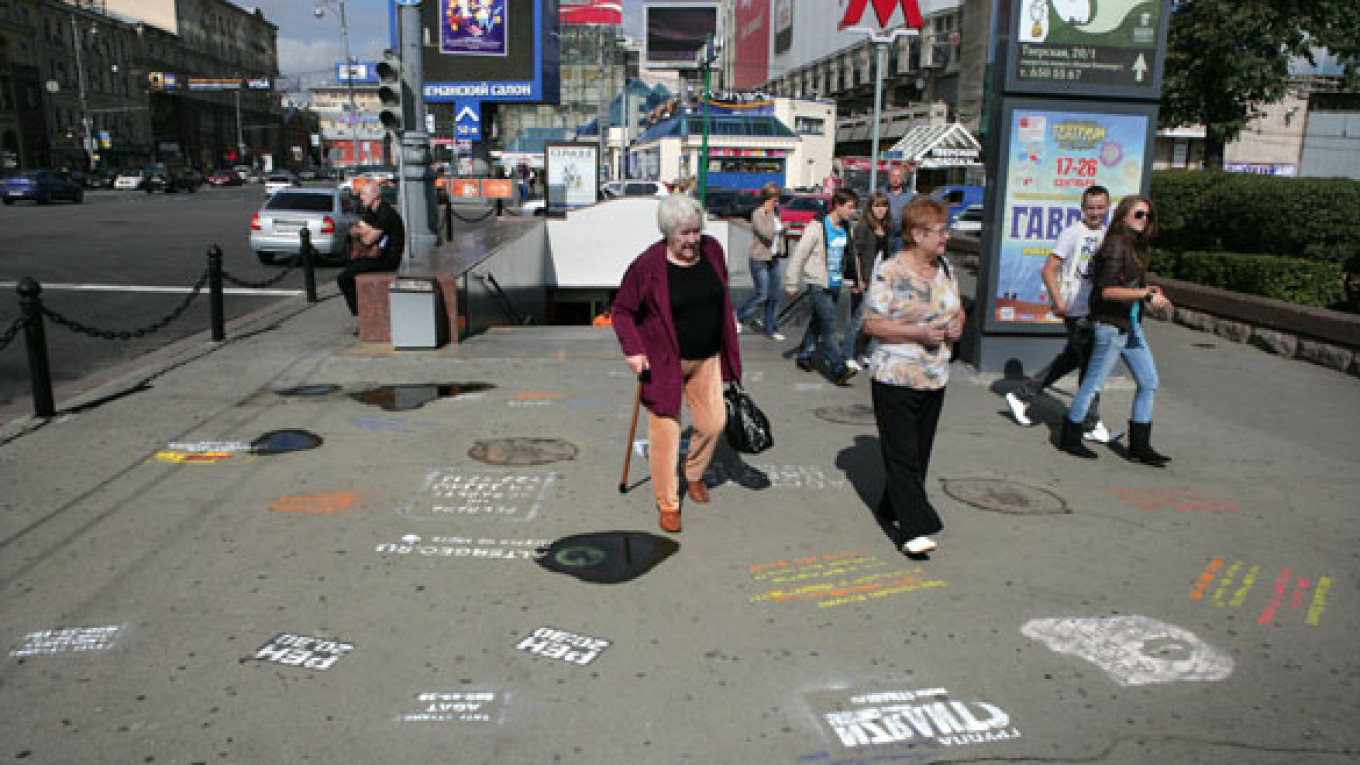When was the last time you looked at the Moscow sky? If you're as busy as most Muscovites, it's probably been a while.
But navigating the city's rundown sidewalks amid the morning rush requires a careful eye on where you're walking. And businesses have taken notice.
Advertising on sidewalks has mushroomed in Moscow over the past year, with colorful images hawking everything from legal services to hair salons springing up outside metro stops and other busy pedestrian areas.
Small advertising agencies, looking for a niche in the billboard-dominated market, have quite literally brought outdoor advertising back down to earth.
Experts say the spray-on ads are on a murky footing legally, and City Hall says it's looking for ways to combat what it considers an eyesore.
The federal law on advertising does not explicitly mention sidewalks, complicating enforcement. The Federal Anti-Monopoly Service, which is responsible for regulating the market, has had plenty of other demands on its attention in the past few years.
In the West, sidewalk campaigns have been widespread for at least a decade. A leader in the so-called guerilla marketing business, New York-based Go Gorilla Media, has been doing ads on the asphalt for more than 10 years, chief financial officer Sasha Engel told The Moscow Times.
"It has evolved over the years to include not only chalk stencils, but also Waterstencils, which we invented in 2007, sidewalk projections, street vinyls, murals, etc.," Engel said.
Placing an image on the asphalt is relatively simple, said Fyodor Masnev, a manager of Reklama na Asfalte, a Moscow-based company that specializes in asphalt advertising.
Most Russian companies use plastic or linoleum stencils. Pressurized paint or water is then sprayed across the stencils, leaving an impression — fuzzier than your average billboard, but adequate for a company logo or basic contact information.
The stencils may be self-made or outsourced. Many are no larger than a sheet of paper, while some can stretch for more than a meter.
"It takes us about 30 minutes to cut out a stencil," Masnev said.
His team usually works at night, when there is little pedestrian traffic. The work requires no more than two people, and solo sprayers are just as common.
Yevgeny, spotted near the Belorusskaya metro station Thursday afternoon spraying sidewalk ads, said he took the job a week ago.
He was asked to put images at every subway exit along the metro's Green Line. Yevgeny said he had just enough time to do one line per day.
"I'm going through a tough time financially, and this job is a good way to make some extra money," said Yevgeny, who gets 1,000 rubles ($32) per subway line.
Most companies offering sidewalk ad campaigns are small and rarely have more than half a dozen employees. Prices vary from a few hundred rubles to a few thousand dollars, depending on the campaign's scale, the size of the image, and the company doing the work.
At Reklama na Asfalte, an average, 60-by-60-centimeter ad costs 800 rubles. For a small store looking to get noticed, 50 images could do the trick, Masnev said, which would bring project's budget to 40,000 rubles, or about $1,300.
The low cost is a top reason behind the street ads' appeal, he said.
"It's the small companies whose products or services are not known to the market that come to us most: photo studios, dental clinics, private services," Masnev said. "They're about 80 percent of our business."
Masnev's firm, owned by his cousin, gets about 10 calls a day, one or two of which become new clients.
D-stance, which offers dance lessons to Moscow children, first used sidewalk advertising last August and decided to do it again this year, said Denis Bondarev, the studio's head.
Bondarev said the ads brought in a substantial portion of his new clients.
About 10 percent of D-stance's seasonal advertising budget — late August to early September and mid-December are peak recruiting periods — is dedicated to sidewalks ads, Bondarev said.
"We use these ads partly because they don't require any type of permits," he said. "There's no guarantee that somebody won't come and erase our ads, but right now this type of advertising isn't regulated by any law.
"As long as you stick to a number of unspoken rules, you're fine," Bondarev said, adding that it was important to avoid historical monuments and roads.
Advertisers try to avoid important architectural sites to avoid vandalism charges. To be on the safe side, many require sprayers to carry printouts of the law to show police.
"We've only been approached once or twice by the police," Masnev said. "Each time we had the printouts. Once, I remember we were asked to leave by the owner of the property where we tried to spray the paint. And we did, no questions asked."
Regulation of sidewalk advertising at the federal level is indeed vague, and experts say specific legislation will be needed before anything can be done about the practice.
The federal law on advertising requires the owner of an ad structure — something like a billboard or bus stop shelter — to sign a contract with the owner of the property on which it is built. In the case of sidewalk advertising, the property is asphalt.
"In this case, one should sign an agreement with the owner of the plot — the asphalt surface. But in Moscow it's next to impossible to determine the owner of a given piece of asphalt," said Anton Krotin, a senior lawyer at the Nalogovik law firm.
"If one had to obey the law, he would have to turn to the municipality to sign a contract to place the ad," he said.
Moscow's housing and public utilities department told The Moscow Times that asphalt may have different owners, depending on the location. Roads within the Moscow Ring Road, or MKAD, are governed by the department. The space between houses is controlled by city prefectures, while territories adjacent to private property belong to the respective owners.
Moscow's rules on installing outdoor advertising structures do not regulate sidewalks simply because they are not included in that law.
"Given the principle that whatever is not banned by the law is allowed, one can conclude that in Moscow, in the absence of a direct ban, placing advertising on sidewalks is legal," Krotin said.
As a result, some cities have prohibited sidewalk advertising. A court in the Sverdlovsk region banned advertising on asphalt in mid-January, Krotin said.
Moscow officials disagree with that interpretation but concede that enforcement is complicated under the current law.
"We have a negative attitude toward advertising on asphalt," Vladimir Makarov, head of City Hall's advertising committee, told The Moscow Times. "Only people who don't love their city are involved in advertising on asphalt. They don't care what it looks like," he said.
The city advertising committee has also recently sought to ban street banners — which city police have called a dangerous distraction to drivers — when their contracts expire in 2013.
Much of the city's pavement is owned by the Moscow city government and other executive bodies, Makarov said. "No one has asked for their permission, so this type of advertising is illegal."
Last month, Makarov asked the anti-monopoly service to provide a ruling on the legality of sidewalk ads, and if necessary, to take measures against ad agencies and their customers.
The service can punish violations under the Administrative Code, and it also has the legal authority to submit a bill to lawmakers banning sidewalk advertising, Krotin said.
But ad firms say even a ban would be unlikely to stop them from using the effective medium, especially if new loopholes could be found.
"[Their effectiveness] is hard to measure, but in large markets such as New York City, and placed in high-traffic locations, each ad will get thousands of impressions per day," Engel said.
Sidewalk ads are illegal in New York, but companies use paint-free materials.
"[This] means nothing is applied to sidewalks and nobody can accuse the advertiser of vandalizing," Engel said.
The methods are also "green," which at this point is the least of Russians' concerns.
"Yeah, sure, the paint is clean," said Yevgeny, the sprayer. "It would come right off."
A Message from The Moscow Times:
Dear readers,
We are facing unprecedented challenges. Russia's Prosecutor General's Office has designated The Moscow Times as an "undesirable" organization, criminalizing our work and putting our staff at risk of prosecution. This follows our earlier unjust labeling as a "foreign agent."
These actions are direct attempts to silence independent journalism in Russia. The authorities claim our work "discredits the decisions of the Russian leadership." We see things differently: we strive to provide accurate, unbiased reporting on Russia.
We, the journalists of The Moscow Times, refuse to be silenced. But to continue our work, we need your help.
Your support, no matter how small, makes a world of difference. If you can, please support us monthly starting from just $2. It's quick to set up, and every contribution makes a significant impact.
By supporting The Moscow Times, you're defending open, independent journalism in the face of repression. Thank you for standing with us.
Remind me later.






